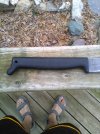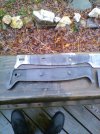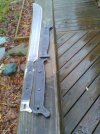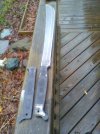- Joined
- Mar 5, 2021
- Messages
- 207
Hello guys and gals. I have a Cold Steel 2 handed Machete that pretty much sucks because of the Polypropylene handle. I truly despise these ugly uncomfortable horrid handles and I am convinced the Poly material takes away the striking force on swing of the blade due to very bad and painful hand shock and the Polypropylene absorbing energy upon striking targets. I need to do 2 things.
1. Thin down the blade angle. Any recommendations on edge changing or degrees?
Should I use a professional knife sharpener for this or buy a Work sharp? If not how do I measure my blade angle and what tools do I need to use to change the bevel and edge?
2. Remove the Polypropylene handle and replace it with another material.
I need something that does not transmit unbearable shock to the hands.
Micarta scales, Leather wrap, G10, Or any other material you may suggest?
3. Is this an undertaking even worth pursuing considering I paid $30 for this 2 handed machete? Or would I be better served to chuck it in the trash or give it to someone else? I also noticed the Tang in the handle looks fairly small and perhaps will only become weaker if I strip the original handle.
Being that this project may be more complicated than what I realized as an amateur hobbyist and not a professional level knife maker. Or not worth the time, money, or headache. As there may be better alternatives.
Here are a few pictures of what I am working with. I will post more as this project comes about if I decide to pursue it.
What I do next is dependent on the input of those who have modded knives and have more experience than myself.


1. Thin down the blade angle. Any recommendations on edge changing or degrees?
Should I use a professional knife sharpener for this or buy a Work sharp? If not how do I measure my blade angle and what tools do I need to use to change the bevel and edge?
2. Remove the Polypropylene handle and replace it with another material.
I need something that does not transmit unbearable shock to the hands.
Micarta scales, Leather wrap, G10, Or any other material you may suggest?
3. Is this an undertaking even worth pursuing considering I paid $30 for this 2 handed machete? Or would I be better served to chuck it in the trash or give it to someone else? I also noticed the Tang in the handle looks fairly small and perhaps will only become weaker if I strip the original handle.
Being that this project may be more complicated than what I realized as an amateur hobbyist and not a professional level knife maker. Or not worth the time, money, or headache. As there may be better alternatives.
Here are a few pictures of what I am working with. I will post more as this project comes about if I decide to pursue it.
What I do next is dependent on the input of those who have modded knives and have more experience than myself.


Last edited:



